
Russian President Vladimir Putin (second from right) sat side-by-side with Chinese President Xi Jinping in Moscow’s Red Square on May 9, as the leaders of two of the world’s most powerful nations reviewed the Victory Parade celebrating the 70th anniversary of the defeat of Nazi Germany at the end of World War II.
In a world that prefers to ignore the threat of communism (whether overtly, such as China’s or hidden below the surface and managed by former KGB officer Putin in Russia) and prefers to constantly sound the alarm about Iran’s “nuclear ambitions,” ISIS, and al-Qaeda, Britain’s Telegraph made a revealing observation in its May 9 report about the Putin-Xi meeting: “Once again, the Russia-China axis is the main threat to the West’s vision of peaceful and prosperous international relations.”
The Telegraph also reported that President Bill Clinton had attended the Moscow Victory Parade back in 1995, standing alongside Chinese President Jiang Zemin and the Russian Federation’s first president, Boris Yeltsin, but that this year, America boycotted the event because of Russia’s occupation of Ukraine’s Crimean peninsula, as well as its support of the Assad regime in Syria and for threatening to sell air defense systems to Iran.
In contrast to the U.S. absence, the communist world and its allies were well represented at this year’s Moscow parade. In addition to Xi, among those who attended were Robert Mugabe of Zimbabwe, Nicolas Maduro of Venezuela, and Raúl Castro of Cuba. John F. Burns of the New York Times wrote in 1980 that Mugabe had earned the reputation “as a Marxist ideologue whose guerrilla forces, in their brutality against black and white civilians, had few counterparts in modern warfare.” Maduro is the successor to the late socialist strongman Hugo Chávez, and has continued his predecessor’s Castro-backed revolutionary regime. And Raúl Castro needs no introduction.
The Telegraph described the gathering by noting: “The line-up of leaders alongside the two men [Putin and Xi] was a walking representation of a new anti-American alliance that has formed bit by bit since the invasion of Iraq demonstrated the frightening ease with which Washington could destroy hostile leaders far away.”
An article about this year’s Moscow Victory Parade in the Atlantic saw it as an illustration of growing Russian-Chinese cooperation. It observed:
As Russia’s relationship with the United States and its European allies grows worse, its ties to China have never been closer. On the eve of the parade last Friday, the two countries announced 32 separate bilateral agreements, including a non-aggression pledge in cyber warfare. The deals complement a $400 billion deal made last May, when Russia agreed to ship 38 billion cubic meters of natural gas each year between 2018 and 2048 to China. And next week, Russian and Chinese naval vessels will conduct live drills in the eastern Mediterranean Sea.
“We are strong if united but weak if isolated,” the article quote Xi as saying.
During the Cold War, when Soviet Premier Nikita Khrushchev told Western ambassadors in Moscow in 1956, “We will bury you!”; when the Soviets tested a 50-megaton nuclear bomb in 1961; when the presence of Soviet missiles in Cuba prompted the Cuban Missile crisis in 1962 and created fears of an impending nuclear war; and when hot versions of the Cold War resulted in Communist China supporting armies fighting against U.S. troops in Korea in the 1950s and Vietnam in the 1960s, any close cooperation between the Soviets and Chinese would have been considered extremely alarming.
Today, though Russia is but a newly branded version of the old Soviet Union (an article in The Economist in 2007 noted: “Political power in Russia now lies with the FSB, the KGB’s successor”), and China is still openly in communist hands, no potential danger from these superpowers can compete for media coverage with the daily reports of threats posed by ISIS and Iran’s “nuclear program.”
Though figures can vary according to who is compiling the statistics, reliable estimates indicate that Russia has approximately 1,600 nuclear warheads, and China has about 250. These nations also possess what are called “nuclear triad” delivery systems for these weapons — strategic bombers, intercontinental ballistic missiles (ICBMs), and submarine-launched ballistic missiles (SLBMs).
The world’s oft-cited major threat to world peace, Iran, in contrast, has nary a nuclear warhead, nor any means of delivering one. Furthermore, its nuclear fuel enrichment program has not produced material of sufficient density to produce nuclear weapons. Iran has reportedly begun the process of enriching uranium fuel to a 20-percent level of U-235 required for a reactor in Tehran that is used to make medical isotopes, but that is considerably below the threshold where it would pose any threat to other nations. Weapons-grade uranium is enriched to about 90 percent U-235.
During the 2012 presidential campaign, candidate Ron Paul said in an interview with CNN’s John King, USA: “There is no evidence whatsoever that the Iranians have or are on the verge of getting a nuclear weapon, according to our own military people, our own CIA, according to the UN.”
That same year, Paul vehemently opposed a bill to impose sanctions on Iran. Paul called the sanctions bill, which passed the House 421-6, the “Obsession with Iran Act 2012.”
The former representative said in a speech: “What we continue to be doing is obsess with Iran and the idea that Iran is a threat to our national security. Iran happens to be a Third World nation. They have no significant navy, air force, or intercontinental ballistic missiles.”
As for ISIS, that other threat to world peace that is in the news almost daily, there is no dispute that it is a terrorist organization of the most radical type and is responsible for countless atrocities wherever it has gained control in Iraq and Syria. However, that other bogeyman, Iran, has actually been active in supporting Shiite militias fighting against ISIS in Iraq. Iran has also supported other enemies of ISIS, most notably Syria’s strongman, Bashar al-Assad.
In an effort to unseat Assad, the United States supplied the anti-Assad forces, linked under the umbrella Free Syrian Army (FSA) with weapons and training. However, several factions within the FSA then supported ISIS, a leading opponent of Assad, and handed over large numbers of weapons to ISIS.
Instead of intervening in the Middle East, where it is often difficult to tell who is friend and who is foe, and where intervention often results in “blowback,” the United States might do better to focus its attention on a real enemy: international communism. From the looks on things in Moscow recently, the worldwide communist network is alive and well.



